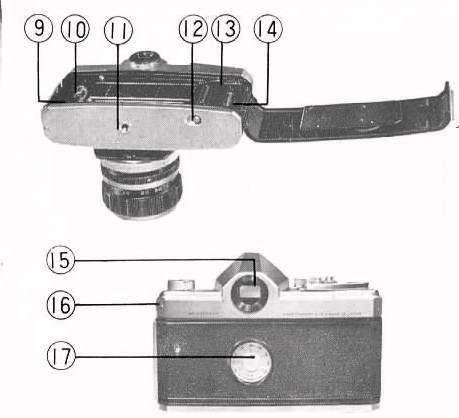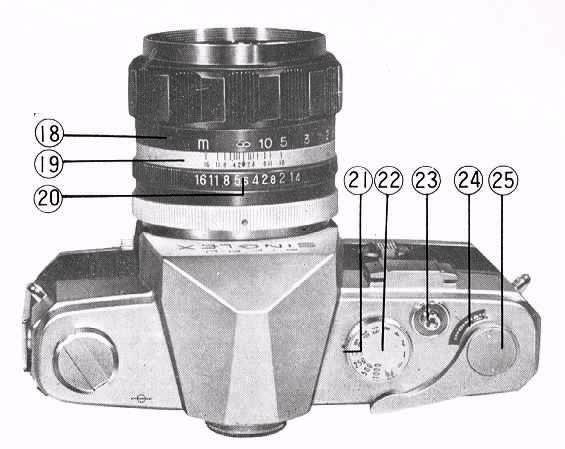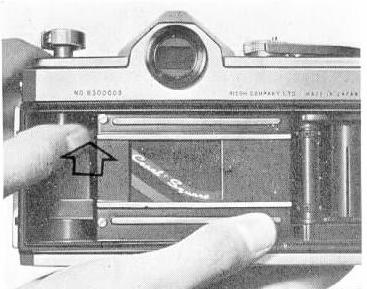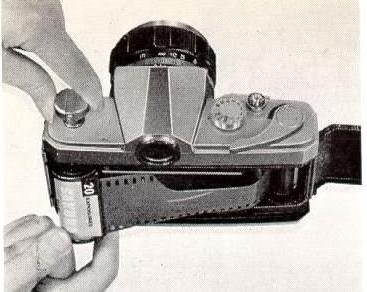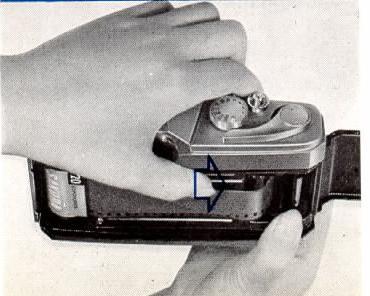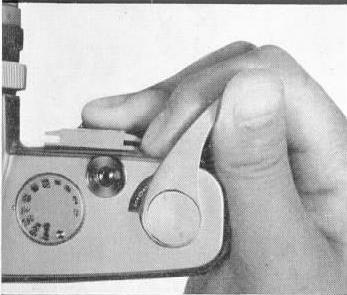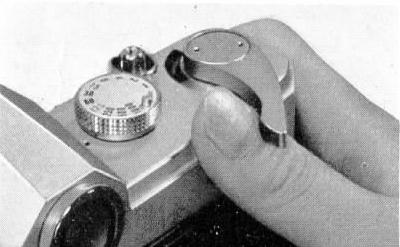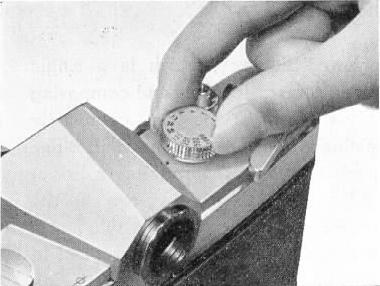
· SETTING THE LENS APERTURE
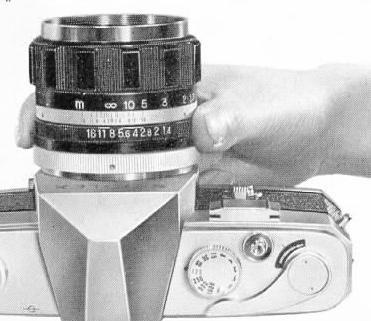
|
The desired aperture opening of lens
is set by rotating the aperture scale ring on the lens barrel to the red
diamond mark on the "depth of field" ring. The diaphragm automatically reopens
to full aperture after each shutter release. Consequently, the field of
view visible before and after the shutter is released. |
· FOCUSING
With your "Singlex", which is a single lens reflex camera,
focusing and composing is achieved through the lens, completely eliminating the
problem of parallax. The penta-prism system incorporates a bright fresnel lens for
clear viewing even to the corners for perfect composition To focus, frame the subject
to be photographed in the viewfinder and rotate the focusing ring either to the
left or right until the split images merge into one clear image.
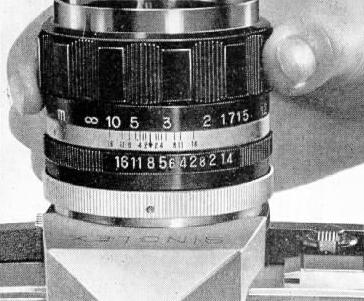
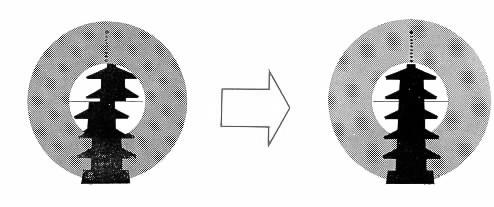
· RELEASING THE SHUTTER TO TAKE PICTURES
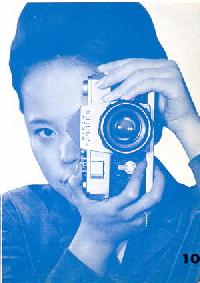
|
With the subject in sharp focus and
properly framed you are ready to take your picture. Press, gently, the shutter
release on top right of camera. Press downward slowly until about half way
and then at the precise moment of expression or Of action, press all the
way. A harsh or jerky motion when used to trigger the shutter release will
result in a blurred picture. Always press the shutter release button in
a slow smooth manner. |
· UNLOADING THE FILM
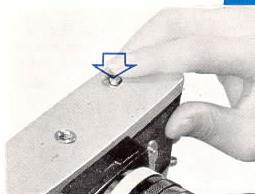
|
As each picture is taken it is recorded
in the film exposure counter window. When the counter reaches 20 or 36,
depending upon the length of roll in the camera, proceed as follows:
Press release pin at the bottom of camera Fold out the rapid rewind lever |
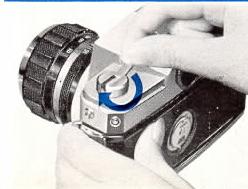
|
Rewind the exposed film back into its film cartridge by rotating the
rewind lever " clockwise" (in direction of arrow on knob) until no tension
is felt. The film is now fully rewound. Unlock back cover and pull
up the rewind lever.
With the back fully opened and the rewind shaft in the " up " position,
turn the camera over and the film will drop out of its own accord.
|
· WAYS TO HOLD CAMERA IN TAKING PICTURES
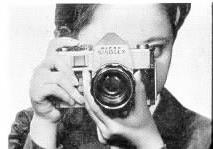
|
1. Hold the camera in both hands using
right index finger to operate the shutter release and left thumb and index
finger to adjust focusing. Use either the left or the right eye for viewing
through the viewfinder eyepiece. Stabilize the camera by pressing left elbow
against your side. |

|
2. Holding camera in upright or vertical
position....There are two ways. One is with shutter release above your eyes
and the other with the release below eyelevel. When held in former way,
the film winding can be done without moving the camera from its shooting
position. |
However, since the camera is held high it is somewhat unstable, ' especially
for slow shutter speeds. When taking still subjects, the latter manner is recommended
as this position is more stable. The shutter release should be
pressed with your thumb. Either way is satisfactory. Choose whichever method suits
your picture taking needs.
· DEPTH OF PHOTOGRAPHIC LENSES AND THEIR UTILIZATION
Photographic lenses are capable off providing sharp focus in front of and behind
the subject actually focused on. For instance, you are shooting
at F2, if you focus on a subject 10 feet away from your lens objects closer than
7-5/8 inches and further than 8-3/4 inches from your main subject will be in acceptable
sharp focus. The front limit to the rear limit in acceptable sharp focus is called
the " Depth of Field " of a lens. This " Depth of. Field" range is shallow in the
foreground and deep in the background and the limits vary with different lens openings
and distances. In actual use the control of the " Depth of Field " serves as a tool
to achieve desired effects and is utilized in the following two ways.
F2
F5.6
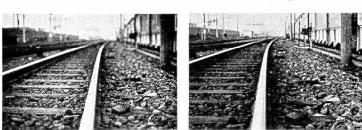
1. To obtain sharp image of subject located at different distances.
2. To limit sharpness and concentrate attention on a specific part of the scene
by having only the specific " scene " sharp.
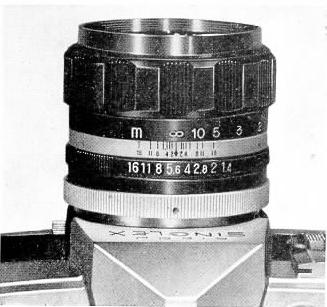
|
Opposite to the distance scale on the lens barrel is a depth of field
scale with lens openings 16, 11, 8, 4, 2 engraved. These, in conjunction
with the distance scale give you the range of the depth for a selected lens
aperture. The following method describes this feature. For instance, when
taking a picture with your subject at 5 feet (1.5 meter) with lens opening
at f/16, the range between the two 16s found on the scale is the distance
of acceptable sharp focus. As you can see from the distance scale the front
limit is 4feet (1.2 meter) and the rear limit 7 feet (2 meters).
|
· LEVER FOR PREVIEWING DEPTH OF FIELD
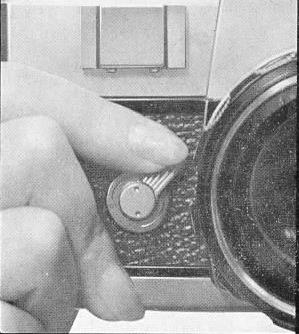
|
Push combined preview-self-timer lever
situated on the right front of camera in direction of "M" till it stops.
The lens opening of the camera will correspond with that which you have
set on the aperture scale. By looking through the viewfinder you will note
the extent of the depth of field. At first it is somewhat difficult to see
the depth, but practice will enable you to use this feature. |
Self-timer
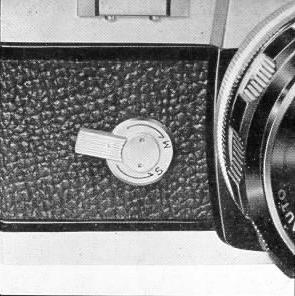
|
The self-timer is built into the right
of camera body. To set, push combined preview-self-timer lever in direction
of "S" until it stops. To release it, depress shutter release.
In 12 seconds it will trip the shutter This lapse of time is enough
to permit you to get yourself into the pictured. The self-timer device
is an excellent means of insuring smooth shutter releasing when very slow
speeds are used. A tripod should also be used to insure steadiness
when taking shots at slow speeds. |
Infrared films
This infra-red marking on the depth of field
scale ring is used for resetting the distance when using Black and White infra-red
film.
After obtaining the correct focus, in the usual way, set the distance
obtained on the scale to the red dot, instead of the red diamond. An infra-red filter
is, of course, required.
· CHANGING THE LENS
This camera has a bayonet fitting mount on the front which permits removal and
replacement of interchangeable lens with speed and ease.
(WEBMASTER: the manual does not state what bayonet type of lens mount.
It could be the Nikon type which I have seen sold on E-bay stating that this particular
model takes the Nikon lenses)
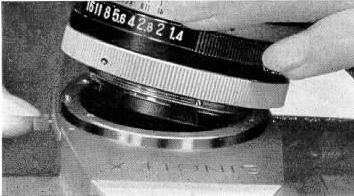
When changing the lens, do so carefully, Especially, in replacing, be sure it
is securely fitted to the bayonet mount. Care should be taken that the rear element
of the lens does not strike against the bayonet mount of the camera
body.
· REMOVING THE LENS
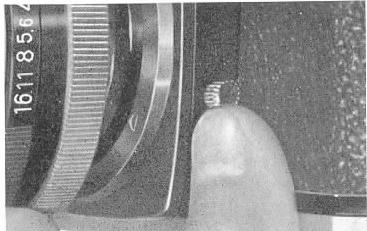
|
Set the distance
scale to infinity by rotating the lens barrel. Press towards the camera
body the lever located at the left of the lens mount. This releases the
catch which holds the lens to the camera. Now, turn lens in clockwise direction
until the red dot on the camera body. Pull lens away from camera body. |
· REPLACING THE LENS
Place lens, line up the red dot on:: the lens barrel with the red dot on the
camera body. Turn lens counter clockwise until a click is heard. This will let you
know your lens is properly seated.
· FLASH SYNCHRONIZATION
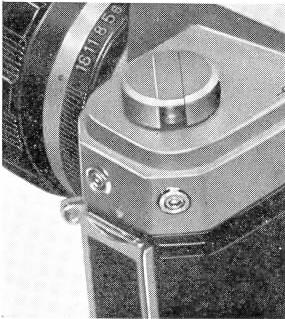
|
Synchronization, here, means the coincidence of the flash with the shutter
opening. The duration of the flash must be long enough to strike the film
during the shutter travel. Now this duration of the flash depends
on the kind of flash bulb you are using. The table on page 20
shows you what shutter speed a certain bulb or an electronic flash will
synchronize when using the "Ricoh Singlex".
|
Two Standard sockets recessed into the left hand end wall of the camera and are
color coded, M in black and X in red indicating the respective contacts, M in black
and X in red. The plug from the flash unit is inserted into the socket M when using
M class flash bulbs and X when using F class bulb or electronic flash unit.
The red 125 on the shutter speed dial indicates the limit of speed when using an
electronic flash unit having zero delay.
| Class |
G. E. Bulb |
Permissible Shutter Speeds |
| M |
( 1 ) PH/5 |
up to 1/1000 sec. |
| " |
(2) PH/5B (for color film) |
" |
| " |
( 3 ) PH/8 |
" 1/125 |
| " |
(4) M 5 |
1/1000 |
| " |
(5) M 5B (for color film) |
" |
| " |
(.6 ) PH/M2 |
1/60 |
| " |
(7) PH/M2B (for color film) |
" |
| " |
(8) AG 1 |
" |
| " |
( 9) AG 1B (for color film) |
" |
| FP |
(10) PH 6 |
1/125 |
| " |
(11) PH/6B (for color film) |
* |
| F |
(12) PH/SM |
1/60 |
| X |
Electronic flash unit, instantaneous firing |
1/125 |
| X |
Electronic flash unit, with firing delay |
1/60 |
FLASH SYNCHRONIZATION NOTE
1. Westinghouse PM/5, Sylvania Press 25, Dura No. 5, No. 5A, Amplex No. 5,
No. 5A, Philips PF 38 are also usable
2. Westinghouse PH/5B, Sylvania Press 25C and Press 25B, Dura No. 5B Amplex No.
5 B are also usable
3. Westinghouse PM/8, Sylvania Bantam 8, Dura No. 8, Amplex PF 4, PF 3 and PF
2 are also usable
4. Sylvania M 25 and M 5 are also usable
5. Sylvania M 25B and M 5B are also usable
6. Westinghouse PH/M2, Sylvania M2, Amplex PF 2 M are also usable
7. Sylvania M 2B is also usable
8. Sylvania AG 1 is also usable
9. Sylvania AG 1 B is also usable
10. Westinghouse PM/6, Sylvania FP 26, Dura No. 6, Philips PF 24, Osram S1, S0
are also usable
11. Westinghouse PH/6B, Sylvania FP26B, Dura No. 6B, Amplex No. 6B
Philips
PF 24/97 and Osram S0 B are also usable
12 Westinghouse PH/SM, Sylvania SF, Dura SM, Amplex No. SM are also usable
· FILM SPEED (ASA and DIN) REMIND DIAL
The numbers 10, 25, 32, 50, 100, 200, 400, 800 and 1600 (11, 15, 16, 18, 21,
24, 27, 30 and 33) on the dial at the camera back are the " ASA " (" DIN ") film
speed guide numbers. Setting the " ASA" (" DIN " number of your film to the black
dot on the center piece serves as a reminder of the kind of film you have loaded
into your " Ricoh Singlex ".
The dial is rotated by using the pin on the dial.



